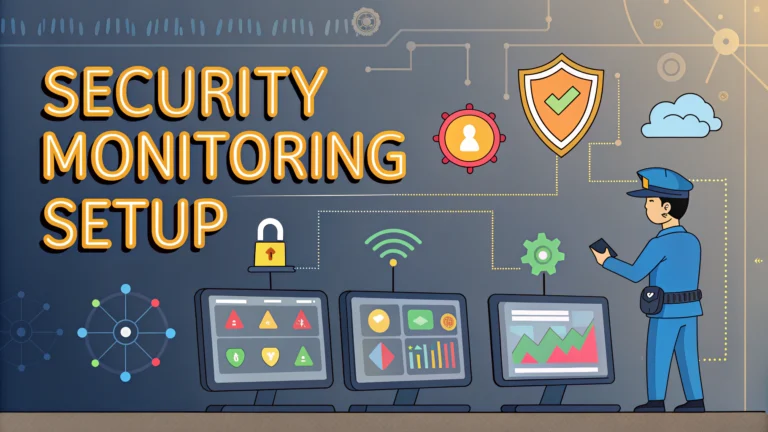A well-designed security monitoring setup forms the foundation of effective penetration testing and vulnerability assessment programs.
This guide outlines key components and best practices for establishing robust security monitoring during penetration testing engagements.
Understanding proper monitoring configurations helps security teams detect and respond to potential threats while maintaining visibility throughout testing activities.
Essential Monitoring Components
- Network traffic analyzers (Wireshark, tcpdump)
- Intrusion Detection Systems (Snort, Suricata)
- Log management solutions (ELK Stack, Splunk)
- System resource monitors
- Security Information and Event Management (SIEM)
Network Traffic Monitoring
Configure network sensors at key points including internet gateways, DMZ interfaces, and critical network segments.
| Tool | Primary Use |
|---|---|
| Wireshark | Deep packet inspection and protocol analysis |
| tcpdump | Command-line packet capture and analysis |
| NetworkMiner | Network forensics and asset discovery |
System Monitoring Setup
- Enable detailed logging on all target systems
- Monitor CPU, memory, and disk usage
- Track process creation and termination
- Record file system changes
- Monitor registry modifications (Windows)
Alert Configuration
Set up alerts for specific indicators of compromise:
- Unusual authentication attempts
- Suspicious network connections
- Abnormal process behavior
- File integrity changes
- Security control bypasses
Documentation Requirements
Record the following information during monitoring:
- Date and time of events
- Source and destination IP addresses
- User accounts involved
- System resources affected
- Actions taken by testers
Monitoring Best Practices
- Implement baselines before testing begins
- Use separate monitoring infrastructure from production
- Maintain detailed logs of all testing activities
- Configure appropriate retention periods
- Test monitoring systems before engagement
Tools and Resources
Recommended open-source monitoring tools:
- Nagios – Infrastructure monitoring
- ELK Stack – Log management and analysis
- Snort – Network intrusion detection
- OSSEC – Host-based intrusion detection
Next Steps for Implementation
Contact security monitoring vendors for professional solutions:
- Splunk Enterprise Security: +1 (866) 438-7758
- IBM QRadar: +1 (877) 426-6006
- AlienVault USM: +1 (888) 613-6023
Monitoring Performance Optimization
- Regular tuning of detection rules
- Optimization of log collection processes
- Storage capacity management
- Alert threshold adjustments
- Performance benchmark tracking
Integration Requirements
Connect monitoring systems with existing security infrastructure:
- Firewall logs and alerts
- Endpoint protection platforms
- Active Directory monitoring
- Cloud service logs
- Application security tools
Compliance Considerations
| Framework | Monitoring Requirements |
|---|---|
| PCI DSS | Daily log reviews, file integrity monitoring |
| HIPAA | Access logging, audit trails |
| SOX | Change monitoring, access controls |
Incident Response Integration
- Establish clear escalation procedures
- Define incident classification criteria
- Document response workflows
- Maintain communication channels
- Regular tabletop exercises
Building Sustainable Security Monitoring
Implement these final steps to ensure long-term monitoring effectiveness:
- Regular review and updates of monitoring strategies
- Continuous staff training on new threats
- Documentation of lessons learned
- Periodic testing of monitoring capabilities
- Alignment with business objectives
Contact your security team or monitoring vendor to begin implementing these practices within your organization’s security framework.
FAQs
- What is security monitoring and why is it crucial for penetration testing?
Security monitoring is the continuous observation and analysis of network traffic, system logs, and security events to detect potential threats and vulnerabilities. It’s essential for penetration testing as it helps identify attack patterns, validate security controls, and ensure the testing activities are properly tracked and documented. - Which tools are commonly used for security monitoring during penetration testing?
Popular tools include Wireshark for network packet analysis, Nagios for infrastructure monitoring, OSSEC for host-based intrusion detection, Snort for network-based intrusion detection, ELK Stack for log analysis, and Security Onion for comprehensive network security monitoring. - How should logging be configured for effective penetration testing monitoring?
Logging should be configured to capture authentication attempts, system changes, network connections, file access, and security events. Enable detailed logging on firewalls, IDS/IPS systems, servers, and critical applications with timestamps and source information. - What are the essential metrics to monitor during a penetration test?
Key metrics include failed login attempts, unusual network traffic patterns, system resource utilization, security event correlations, file integrity changes, network latency, and any anomalies in user behavior or system operations. - How can organizations ensure their monitoring setup doesn’t interfere with penetration testing?
Organizations should whitelist penetration testing IP addresses, create separate testing environments when possible, coordinate with security teams, and maintain detailed documentation of testing activities to distinguish them from actual threats. - What are the best practices for alert configuration during penetration testing?
Configure alerts with appropriate thresholds to avoid false positives, establish clear escalation procedures, set up real-time notifications for critical events, and ensure alerts include relevant context for quick analysis. - How should baseline behavior be established before penetration testing?
Document normal network traffic patterns, typical system performance metrics, standard user behavior, and regular security event volumes. This baseline helps identify deviations during testing and assists in impact assessment. - What role does SIEM play in security monitoring for penetration testing?
Security Information and Event Management (SIEM) systems correlate security events, provide real-time analysis, facilitate incident response, and generate comprehensive reports of penetration testing activities and their impact on security controls. - How should organizations handle data retention during security monitoring?
Implement appropriate data retention policies that comply with regulatory requirements, maintain sufficient history for trend analysis, and ensure critical security events are archived for future reference and audit purposes. - What network segments should be prioritized for monitoring during penetration testing?
Focus monitoring on critical infrastructure, segments containing sensitive data, authentication systems, public-facing services, and areas where valuable assets are stored. Ensure comprehensive coverage of both internal and external network boundaries.







